Focus on how polyester chain plays out after CNY holiday
As an old saying goes, “As January goes, so goes the year”. During Chinese New Year holiday, travelling activity recovered, and market participants were looking forward to opportunities in 2023. Then, let’s have a glance at market situation during the holiday and the focus after the holiday.
Economy situation was stable, and demand in China was optimistic.
During Chinese New Year holiday, the economic situation was quite stable. WTI crude oil futures price hovered around $80/bbl, and US dollar index was around 101. Economic data outside China was mixed. On the one hand, US economy shrugged off recession risk temporarily, and European economic forecast rebounded. On the other hand, PMI and inflation expectation fell back, and thus the expectation of slowdown in interest rate hike augmented.
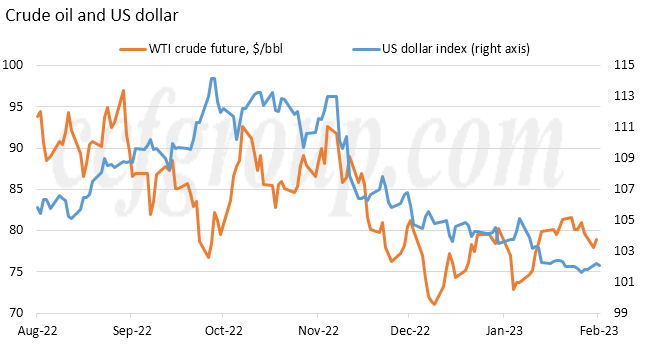
In China, travelling and consumption picked up with COVID restrictions lifted. During the holiday, national travelling activity recovered to 88.6% of the level in the beginning of 2019, with tourism income increasing by 30% on year and recovering to 73.1% of the level in the same period of 2019. Movies during the holiday recorded the second high in China box office history. Amid the rosy picture, market participants were optimistic about the consumption after the holiday.
PX remained strong during the holiday, while inventory was expected to rise in Q1.
PX was strong and its spread to naphtha widened during the holiday.
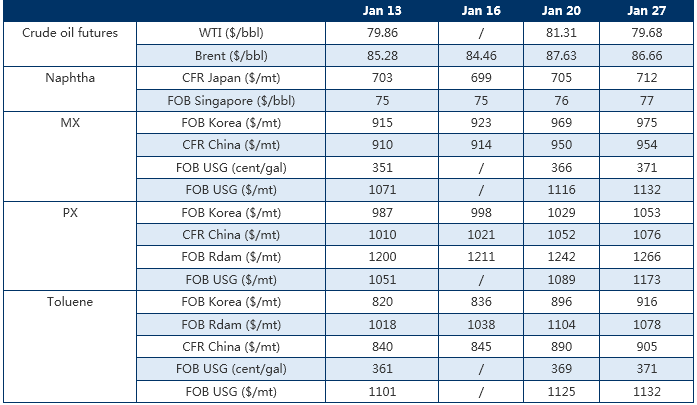
Demand for PX increased with PTA plant operating rate rising. Feedstock inventory at PTA plants was low after the continuous PX inventory reduction in 2022. In addition, 2023 PX term contract made slow progress. Therefore, PX market was supported by buying activities from PTA plants.
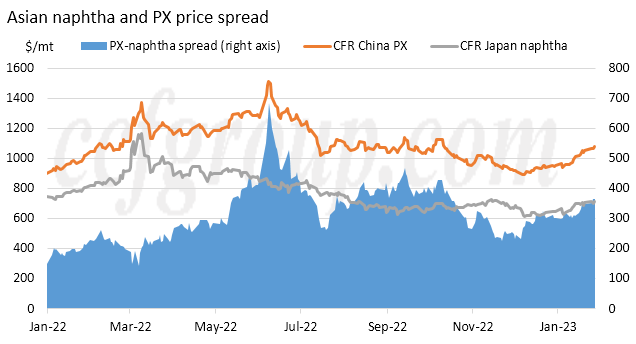
Afterwards, PX inventory is expected to increase in the first quarter of 2023, while several plants are expected to begin turnarounds in the second quarter. Therefore, PX market sentiment is under debate between inventory rise and plant turnarounds.
PTA is under pressure of rising inventory in Jan-Feb, and new plants and demand recovery should be watched closely.
Though PX was strong, PTA kept consolidation amid wait-and-see sentiment. PTA plant operating rate rebounded, and the market was under challenge from increasing inventory as supply outpaced demand.
The operating rate ticked up to around 76-77% with plants restarting, while polyester plant operating rate dropped before rising. PTA inventory is expected to increase by more than 1 million tons in Jan-Feb.
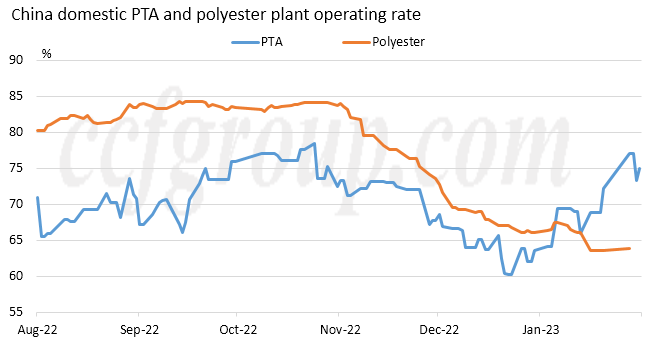
In the short term, spot PTA market is under pressure of increasing inventory, and spot to futures spread may narrow but the squeeze could be capped. The transfer of PTA inventory after logistics recovery is noteworthy.
In the medium run, any adverse impact from new plants and end-use demand recovery should be watched closely.
MEG inventory is expected to pile up sharply in Jan-Feb, and somel large integrated plant shut.
MEG inventory is also estimated to rise in Jan-Feb. MEG coastal inventory at the main ports of East China was assessed at around 1.101 million tons as of Jan 28, up 180kt from Jan 16. Based on supply and demand assessment, MEG inventory was expected to increase by 380kt in Jan, in which 200kt was from coastal inventory.
In addition, polyester plants increased MEG stocks obviously in early and mid-Jan, and the product stocks at MEG plants rose in the end of the month.
However, MEG profit is expected to rebound from Mar amid the recovery of demand and commodity market.
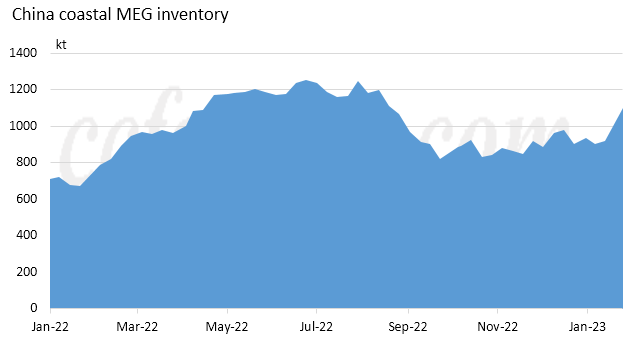
In terms of plant operations, oil-based MEG plant operating rate dropped by 5.3 percentage points from the level before the holiday to 59.6%, as some large plant shut, while coal-based MEG plant operating rate stabilized at 57.5%.
PFY supply is expected to recover amid low inventory and profit rebound.
Driving by restocking demand prior to the holiday, PFY sales were good. The inventory was only 3~4 days after the holiday as plant operating rate was quite low.
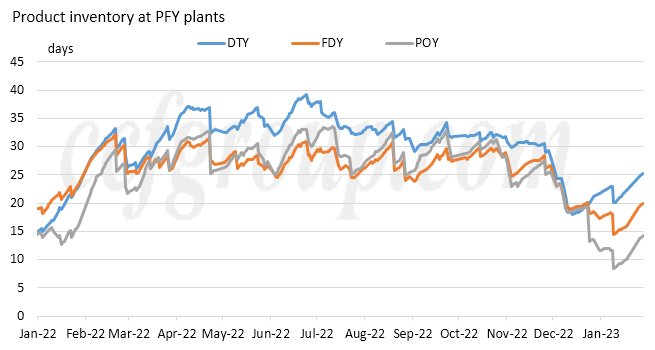
PFY made a good beginning after the Chinese New Year holiday, with relief from inventory and active market sentiment. Low inventory and profit recovery could lead to rebound in PFY plant operating rate which is anticipated to rise to above 70% in Feb.
As for new plant, large companies such as Tongkun and Xinfengming are gearing up and expected to start new plants in the first quarter.
As downstream plants restocked in advance prior to the holiday, sales of PFY could may quieten in Feb. However, PFY inventory may begin increasing amid supply growth in Feb, brining pressure during late Feb till Mar.
Some downstream plants started as early as in end-Jan, while intensive restarts will not begin until H1 Feb, similar to the situation in previous years.
Feedstock inventory at end-use plants was mixed, ranging from 7-15 days to 1-2 months. The average level was slightly below 25 days. It was stocked prior to the holiday, while stocking demand after the holiday was lukewarm.
The risk would come from lack of new orders, according to the feedback from downstream weaving mills, and therefore weaving operating rate is in the lack of support.
PSF is under pressure from supply overhang.
PSF price advanced after the holiday, but transaction remained thin. Some polyester yarn spinners are expected to raise prices by 500yuan/mt after the holiday.
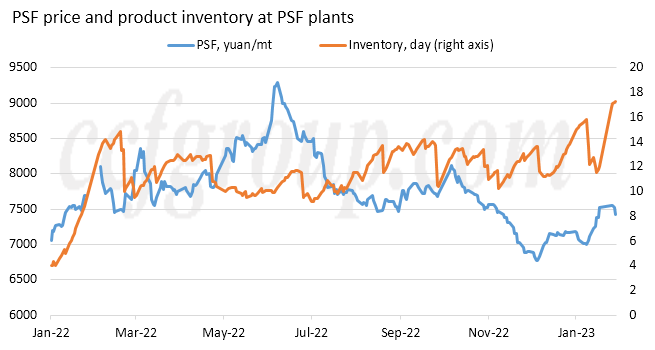
During the holiday, PSF plants cut production, while migrant workers would return during Jan 28 to Feb 5, and then PSF plant operating rate is expected to rebound to above 80% in mid-Feb. Meanwhile, downstream spinner operation is expected to recover by mid-Feb.
PSF stocks at yarn spinners are currently at around 20 days and the stocks in some spinners can be used till end-Feb, after the restocking amid buoyant PSF futures. With feedstock at one-year high, buying activity afterwards would be limited. However, product inventory at yarn spinners is quite low, at around a half month, low point in one year.
PSF market is expected to be under pressure from supply overhang in Feb, as plant operating rate recovers rapidly after the holiday, while spinners have not yet begun purchasing.
- Top keywords
- Cotton Price
- Cotton Futures Price
- Cotton Futures
- CZCE
- PTA Futures Price
- Chemical Fiber
- Polyester Prices
- Wool price
- PTA Futures
- Shengze Silk
- China
- Yarn Price
- price
- China Textile City
- Fibre Price
- Benzene Price
- Cotton
- Index
- Cotton Index
- PTA
- fabric price
- NYMEX
- Top 10
- textile industry
- Spot Cotton
- Cotton Yarn
- Polyester Price
- Futures
- PTA Price
- cotton yarn price

